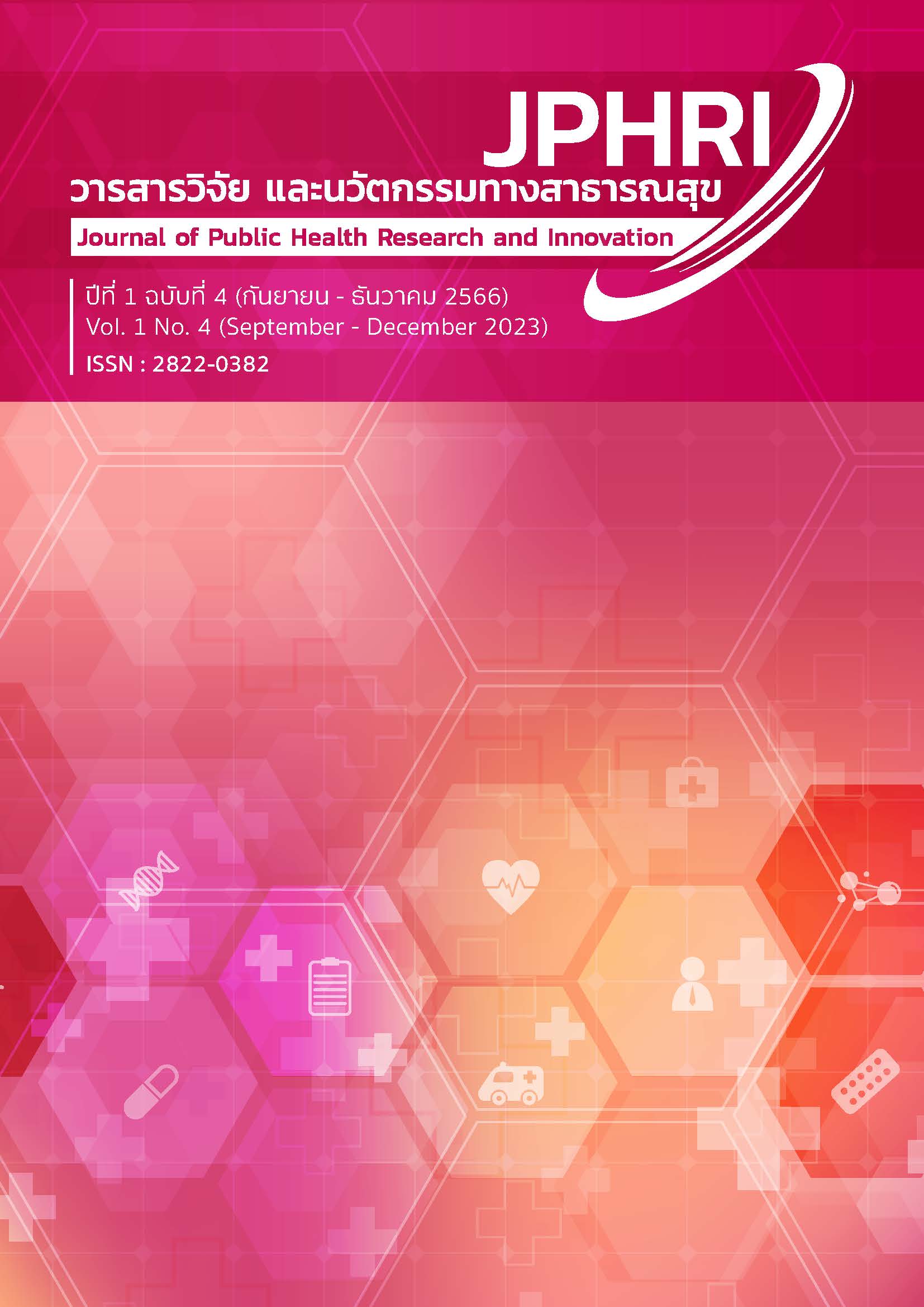ปัจจัยที่มีความสัมพันธ์ต่อการเกิดโรคหลอดเลือดสมองในผู้ป่วยโรคความดันโลหิตสูง อำเภอละงู จังหวัดสตูล
Main Article Content
บทคัดย่อ
บทนำ: โรคหลอดเลือดสมองเป็นสาเหตุสำคัญของการป่วย และเสียชีวิตของประชาชนทั่วโลก ซึ่งโรคความดันโลหิตสูงก็เป็นอีกหนึ่งปัจจัยเสี่ยงสำคัญที่ทำให้เกิดโรคดังกล่าว วัตถุประสงค์เพื่อศึกษาปัจจัยที่มีความสัมพันธ์กับการเกิดโรคหลอดเลือดสมองในผู้ป่วยโรคความดันโลหิตสูง อำเภอละงู จังหวัดสตูล
วิธีการศึกษา: เป็นการศึกษาวิจัยแบบ Retrospective study โดยมีกลุ่มตัวอย่าง คือ ผู้ป่วยโรคหลอดเลือดสมอง จำนวน 199 คน เก็บรวบรวมข้อมูลจากฐานข้อมูลเวชระเบียนของโรงพยาบาลละงู ระยะเวลา 5 ปีย้อนหลัง (2560-2564) โดยใช้วิธีการสุ่มตัวอย่างอย่างง่าย เก็บรวบรวมข้อมูลระหว่างเดือนมกราคม-มีนาคม 2565 บันทึกข้อมูลลงในโปรแกรม Epi-data v.3.1 และวิเคราะห์ข้อมูลด้วยโปรแกรม R โดยใช้สถิติ logistic regression นำเข้าตัวแปรที่มีค่า p-value<0.25 และวิเคราะห์หลายตัวแปรโดยนำเสนอค่า Adjust odds ratio และช่วงความเชื่อมั่นที่ 95%
ผลการศึกษา: ผู้ป่วยโรคหลอดเลือดสมองที่เป็นโรคความดันโลหิตสูงร่วมด้วยมีอายุเฉลี่ย 72.7ปี (SD±13.60) และผู้ป่วยโรคหลอดเลือดสมองที่ไม่เป็นโรคความดันโลหิตสูงร่วมด้วยมีอายุเฉลี่ย 66.7 ปี (SD±13.70) ปัจจัยที่มีความสัมพันธ์กับการเกิดโรคหลอดเลือดสมองในผู้ป่วยโรคความดันโลหิตสูงอย่างมีนัยสำคัญทางสถิติ 0.05 คือ ผู้ป่วยที่มีอายุ 60 ปีขึ้นไป (OR=1.9, p-value=0.046) เป็นโรคเบาหวานร่วมด้วย (OR=4.0, p-value <0.001) ค่าระดับน้ำตาลในเลือด 100-125 mg/dl (OR=4.1, p-value<0.001) ค่าน้ำตาลในเลือดมากกว่า 126 mg/dl (OR=4.4, p-value<0.001) และค่าอัตราการกรองไตอยู่ในระยะที่ 3 (OR=3.2, p-value=0.008)
สรุปผล: ผู้ป่วยที่มีอายุ 60 ปีขึ้นไป มีโรคเบาหวานร่วมด้วย ค่าระดับน้ำตาลในเลือดสูง และมีค่าอัตราการกรองไตระยะที่ 3 มีความสัมพันธ์กับการเกิดโรคหลอดเลือดสมองในผู้ป่วยโรคความดันโลหิตสูงอย่างมีนัยสำคัญทางสถิติที่ระดับความเชื่อมั่น 95%
Article Details

This work is licensed under a Creative Commons Attribution-NonCommercial-NoDerivatives 4.0 International License.
References
Lo EH, Dalkara T, Moskowitz MAJNrn. Mechanisms, challenges and opportunities in stroke. 2003;4(5):399-414.
González RG, Hirsch JA, Koroshetz W, Lev MH, Schaefer PW. Acute ischemic stroke. New York: Springer; 2011.
World Stroke Organization. Up again after stroke. Available at: http://www.worldstrokecampaign. org. Accessed on 23 September 2021.
Health Data Center. Prevalence of stroke. Available at: https://hdcservice.moph.go.th/hdc/reports. Accessed on 1 October 2021.
Della-Morte D, Guadagni F, Palmirotta R, Testa G, Caso V, Paciaroni M, et al. Genetics of ischemic stroke, stroke-related risk factors, stroke precursors and treatments. 2012;13(5):595-613.
Guzik A, Bushnell CJCLLiN. Stroke epidemiology and risk factor management. 2017;23(1):15-39.
Boehme AK, Esenwa C, Elkind MSJCr. Stroke risk factors, genetics, and prevention. 2017;120(3):472-95.
Shou J, Zhou L, Zhu S, Zhang XJJoS, Diseases C. Diabetes is an independent risk factor for stroke recurrence in stroke patients: a meta-analysis. 2015;24(9):1961-8.
Renna, R., Pilato, F., Profice, P., Della Marca, G., Broccolini, A., Morosetti, R., ... & Di Lazzaro, V. (2014). Risk factor and etiology analysis of ischemic stroke in young adult patients. Journal of stroke and cerebrovascular diseases, 23(3), e221-e227.
Department of medical services. Thailand Medical Services Profile 2011-2014. Nonthaburi: Ministry of public health; 2014.
Kuriakose D, Xiao ZJIjoms. Pathophysiology and treatment of stroke: present status and future perspectives. 2020;21(20):7609.
Health Data Center. Stroke and Hypertension. 2021. Available at: https://hdcservice.moph.go.th/hdc/ reports/page.php?cat_id=6a1fdf282fd28180eed- 7d1cfe0155e11. Accessed on 23 June 2021.
Lemeshow S, Hosmer DW, Klar J, Lwanga SK, World Health Organization. Adequacy of sample size in health studies. Chichester: Wiley; 1990.
Hanchaiphiboolkul S, Poungvarin N, Nidhinandana S, Suwanwela NC, Puthkhao P, Towanabut S, Tantirittisak T, Suwantamee J, Samsen M. Prevalence of stroke and stroke risk factors in Thailand: Thai Epidemiologic Stroke (TES) Study. Journal of the Medical Association of Thailand. 2011;94(4):427-436.
O’Donnell MJ, Xavier D, Liu L, Zhang H, Chin SL, Rao-Melacini P, et al. Risk factors for ischaemic and intracerebral haemorrhagic stroke in 22 countries (the INTERSTROKE study): a case-control study. The Lancet. 2010;376(9735):112-23.
Sarfo FS, Mobula LM, Sarfo-Kantanka O, Adamu S, Plange-Rhule J, Ansong D, et al. Estimated glomerular filtration rate predicts incident stroke among Ghanaians with diabetes and hypertension. Journal of the Neurological Sciences. 2019;396:140-7.

